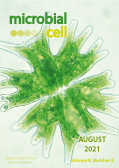Table of contents
Volume 8, Issue 8, pp. 164 - 202, August 2021
Cover: Micrasterias as seen under a light microscope. Micrasterias (order Desmidiales) is a unicellular green alga found in fresh water, which varies in size depending on the species and may reach up to hundreds of microns. Micrasterias species consist of two semicells that are almost entirely filled with chloroplasts, with a nucleus that lies at the center, where the two semicells are joined together. The gaps between the two semicells are joined by an isthmus (information and image retrieved via Wikimedia/Wikipedia; image by Ajburk; the image was modified by MIC). The cover is published under the Creative Commons Attribution (CC BY) license.
Enlarge issue cover
Exploring absent protein function in yeast: assaying post translational modification and human genetic variation
Christina S. Moesslacher, Johanna M. Kohlmayr and Ulrich Stelzl
Reviews |
page 164-183 | 10.15698/mic2021.08.756 | Full text | PDF |
Abstract
Yeast is a valuable eukaryotic model organism that has evolved many processes conserved up to humans, yet many protein functions, including certain DNA and protein modifications, are absent. It is this absence of protein function that is fundamental to approaches using yeast as an in vivo test system to investigate human proteins. Functionality of the heterologous expressed proteins is connected to a quantitative, selectable phenotype, enabling the systematic analyses of mechanisms and specificity of DNA modification, post-translational protein modifications as well as the impact of annotated cancer mutations and coding variation on protein activity and interaction. Through continuous improvements of yeast screening systems, this is increasingly carried out on a global scale using deep mutational scanning approaches. Here we discuss the applicability of yeast systems to investigate absent human protein function with a specific focus on the impact of protein variation on protein-protein interaction modulation.
Genome, transcriptome and secretome analyses of the antagonistic, yeast-like fungus Aureobasidium pullulans to identify potential biocontrol genes
Maria Paula Rueda-Mejia, Lukas Nägeli, Stefanie Lutz, Richard D. Hayes, Adithi R. Varadarajan, Igor V. Grigoriev, Christian H. Ahrens and Florian M. Freimoser
Research Articles |
page 184-202 | 10.15698/mic2021.08.757 | Full text | PDF |
Abstract
Aureobasidium pullulans is an extremotolerant, cosmopolitan yeast-like fungus that successfully colonises vastly different ecological niches. The species is widely used in biotechnology and successfully applied as a commercial biocontrol agent against postharvest diseases and fireblight. However, the exact mechanisms that are responsible for its antagonistic activity against diverse plant pathogens are not known at the molecular level. Thus, it is difficult to optimise and improve the biocontrol applications of this species. As a foundation for elucidating biocontrol mechanisms, we have de novo assembled a high-quality reference genome of a strongly antagonistic A. pullulans strain, performed dual RNA-seq experiments, and analysed proteins secreted during the interaction with the plant pathogen Fusarium oxysporum. Based on the genome annotation, potential biocontrol genes were predicted to encode secreted hydrolases or to be part of secondary metabolite clusters (e.g., NRPS-like, NRPS, T1PKS, terpene, and β-lactone clusters). Transcriptome and secretome analyses defined a subset of 79 A. pullulans genes (among the 10,925 annotated genes) that were transcriptionally upregulated or exclusively detected at the protein level during the competition with F. oxysporum. These potential biocontrol genes comprised predicted secreted hydrolases such as glycosylases, esterases, and proteases, as well as genes encoding enzymes, which are predicted to be involved in the synthesis of secondary metabolites. This study highlights the value of a sequential approach starting with genome mining and consecutive transcriptome and secretome analyses in order to identify a limited number of potential target genes for detailed, functional analyses.










